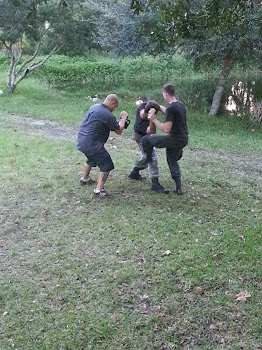Wednesday, October 1, 2014
Thursday, September 11, 2014
Using Strength in ninjutsu
Jon Hass over at Warrior Fitness posted this excellent explanation of where strength fits into ninjutsu:
A common misconception that you’ll hear bandied about from dojo to dojo all across the world is that strength, and by association overall, general fitness, is not required. I think this has to do with a fundamental misunderstanding of how we train. In class, when practicing techniques, it is imperative to be as efficient in one’s movement as possible, and thus avoid using excess, unnecessary power (read – strength). In order to accentuate the study of distance, timing, angling, and space management, one must put strength on the back burner in the dojo to avoid powering through the movements and missing all the wonderful subtleties that taijutsu has to offer. However, in an actual conflict, you can and in fact, you must, use all your power, including strength, to survive. As Jack Hoban said in his interview here, “real fights are very physical – tiring and punishing”. Anyone who thinks physical fitness isn’t required in the traditional martial arts is really just kidding themselves.
Full article: http://warriorfitness.org/fitness-requirements-for-bujinkan-martial-arts-training/
Wednesday, April 23, 2014
Train as you fight, fight as you train
Tuesday, April 22, 2014
Ninjutsu / Taijutsu versus other martial arts
Boxing, kickboxing, karate, MMA, Brazilian jujitsu etc. are real brutal, strong and effective fighting styles. How would you use Ninjutsu to defeat such strong opponents? posted by Andrew Wong
I replied with:
Realize that those arts you listed are 'Sports' martial arts. In other words they train and fight by certain rules. In ninjutsu we train to end a confrontation within seconds...not to fight for 3 rounds. So we would do the unexpected and if need be fight dirty to survive and live another day.Now more in depth:
I agree that these guys train hard and can kick some serious ass. They are tough and very strong, particularly the MMA guys. I would not want to go into the ring with any of them. How they take the pounding they receive in the ring is amazing. Luckily for us from a self-defense stand point we probably won't ever have to worry about going up against these guys. We have to watch out for the drunk or drugged out idiots or desperate thieves, etc.
But....lets say you have to go toe to toe with one of these guys, professional fighters. They are strong, well trained and can take a pounding. So what do we do in this situation?
Some guidelines:
- First, don't go toe to toe!! Evade, angle, get behind them. Never stand there face to face exchanging blows.
- Second, you won't be able to out muscle these guys. Remember natural body weight and flowing motion.
- Third, Soften them up. Strike their over-amped muscles, they make great targets and your opponent isn't used to getting hit there. They are used to getting hit from body blows, head shots and shin strikes against the legs. So go for the biceps, quadriceps, you know actual muscles. Try grabbing and digging you fingers into their pectorals as one example.
- Fourth, actual targets for attacks would be the opponents knees, groin, throat area, eyes, etc. These are called 'Soft targets'. Avoid the areas that they actually train to get hit on. These guys allow are de-sensitized to getting pounded by an opponent.
- Fifth, you will have to fight dirty. Spit in their face or throw sand (distraction). Pull their hair. Get behind them and go for the eyes, nose, and throat.
- Sixth, Do the unexpected. Be invisible.
- Seventh, and most important. If you can avoid the situation altogether then do so. There is nothing wrong with running. Escape and evasion is a ninjutsu skill you should practice!!
Distance - Maai

Source: Kerwin Rodriguez (https://www.facebook.com/groups/2204541888/)
Thursday, April 10, 2014
Muto Dori Hiden
Friday, April 4, 2014
Masaaki Hatsumi - Progression of technique




